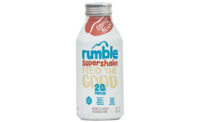
Spotlight on Whey
by Lori Dahm
New research shows substantial health benefits from
a once waylaid ingredient.
One of the most exciting research discoveries in the
world of nutritional ingredients today is the plethora of health benefits
being documented related to whey protein.
The dairy industry has been enmeshed in the world of
whey for the last five or 10 years, investing heavily in research to
generate a body of data and documentation that indicates whey has
significant health benefits that are extremely relevant for today’s
consumer. In addition, some of the breakthrough research indicates the
far-reaching effects of whey such as its ability to help with rare diseases
or emergency room medical situations.
For now, as an ingredient in food and beverage
applications for the consumer, the health benefits whey delivers are
substantial and topical. Whey is on its way to hitting the radar screen in
the industry due to its potential as an ingredient that can address the
nutrition and wellness concerns that are top of mind for consumers.
Whey History
Of course, whey was once the ugly stepchild of cheese,
a byproduct that was a concern to manufacturers only because of the need
for its disposal. Whey has come a long way since then, first becoming an
ingredient of value in the sports nutrition arena decades ago, where its
benefit as a high-quality protein was well known.
“Whey protein first became popular in the area
of sports nutrition, where it was understood in terms of its effects after
strenuous, weight-bearing exercise to rebuild muscle,” says Pete
Huth, director of regulatory and research transfer at Dairy Management Inc.
(DMI), Rosemont, Ill. “The first push of whey research documented a
consistent ability of whey protein to resynthesize muscle that was lost
during these bouts of exercise. The data and scientific literature
indicates that it is the particular composition of whey protein and its
branched chain amino acids that appear to be responsible for this
effect.”
Whey protein is one of the highest-grade proteins
available in the food industry. Its proportion of essential amino acids,
including branched-chain amino acids, is similar to the amino acid needs of
the body. The amino acid profile of whey is almost identical to that of
skeletal muscle, and whey protein supplements generally provide a higher
dose of the essential amino acids than other protein sources.
“Whey protein isolate is an excellent quality
protein, scoring high marks in all measures of protein quality,” says
Kelly Czerwonka, marketing manager at Glanbia, Monroe, Wis. “Whey
protein isolate has the highest level of branched chain amino acids, making
it extremely nutritionally valuable — it is particularly popular
among body builders.”
Whey protein is the richest known source of the
branched chain amino acids (BCAAs) leucine, isoleucine and valine, and it
is these BCAAs which have been shown to be pivotal in sports nutrition and
muscle metabolism. Leucine in particular has become the subject of study in
sports science and muscle metabolism recovery. Studies demonstrate that
leucine plays a key role in muscle protein synthesis, which promotes
better, more efficient muscle recovery after exercise training.
In addition, whey protein concentrate and isolate are
sources of bioavailable cysteine at high levels, which is known as a
conditional amino acid. Cysteine is important to the preservation of lean
body tissue, particularly during exercise.
This research documenting the ability of whey protein
to maintain and build lean muscle mass led to new research projects with
whey designed to understand whether whey ingredients could play a part in
weight management. The results in this direction are promising.
“There is very intriguing research being
completed at the University of Illinois wherein three studies have
documented the possibility of whey to be utilized for weight control when
part of a high-protein diet. There is compelling evidence showing the
consistent effects of whey in this regard,” Huth says. “In
these studies, whey as a high-quality protein that was part of a
low-carbohydrate, high-protein diet, indicated whey results in a reduction
in body weight and body fat, as well as having a positive blood glucose and
insulin effect.”
The suggestion that whey protein as an ingredient can
play a part in weight management is significant in today’s climate
where an estimated two-thirds of the nation struggles with obesity. More
news in this respect is that whey protein ingredients are being shown to
have an effect in reducing hunger and increasing satiety.
“The benefits of whey all seem to be in the
quality of the protein and related to specific types of amino acids that
are enriched in whey protein, the branched-chain amino acids and more
specifically the leucine,” Huth says. “Researchers have
determined that leucine serves as a regulatory amino acid for protein
synthesis as part of the process for maintaining lean body mass.”
Hyptertension Health
Outside of regulating muscle mass and body weight,
whey protein has also been shown to have blood pressure regulating
properties. Hydrolized whey protein has been the subject of studies
determining that certain components of whey made available through
hydrolization have blood pressure lowering effects. A key study presented
at the 4th International Whey Conference, hosted by the American Dairy
Products Institute last September, showed hydrolyzed whey protein a
systolic blood pressure lowering effect of 11 millimeters of mercury and a
diastolic blood pressure lowering effect of 7 millimeters.
“There are already beverages on the market in
Europe and Japan that are fluid milk products with hydrolyzed casein in
whey which are marketed for their anti-hypertensive and blood pressure
lowering effect,” Huth says. “These products are consistent
with our research here in the United States documenting the ability of
hydrolyzed whey protein to lower blood pressure, and this may be the new
entry for whey in the United States as a nutraceutical product.”
Therein lies the rub: Although whey ingredients have
been documented to have substantial health benefits in the realm of weight
management, lean muscle mass maintenance, anti-hypertension and even some
positive blood lipid effects, whey’s presence within actual retail
products has not reached anywhere near its full potential at this point.
“Whey protein is an ideal ingredient for use in
many drinks that could boast health benefits, because whey protein is easy
to use, can be used in clear drinks at low pH, and is relatively free of
taste,” says K.J. Burrington, dairy ingredients applications program
director at the University of Wisconsin Center for Dairy Research, Madison.
“Right now the mainstream market products that include whey are
primarily the yogurt drinks or the smoothie drinks that include whey
protein for its enhanced protein boost. There are a number of drinks
designed for body builders and weight lifters with up to 40 grams of whey
protein per serving, but these are generally sold in health
stores.”
Beverages are considered a ripe opportunity for using whey protein
ingredients to create products that offer health benefits.
“Beverages are definitely a key delivery system
for whey protein. Whey protein isolate and whey protein concentrate are
used in a range of beverages, including dry blended — primarily
sports and weight loss drinks — and ready-to-drink smoothies,
milk-based beverages, clear sports beverages, juice-based drinks, clinical
nutrition drinks and more,” Czerwonka says. “Driving whey
protein’s use in beverages is the growth of the functional beverages
category, which continues to grow as people become increasingly health
conscious.”
Whey proteins are ideal for their nutritional punch in
sports beverages because whey ingredients can be used in clear beverages
with a pH from 3 to 4.5, offering high solubility. “Where the
functionality and performance of whey proteins really stand out in the
beverage arena is in drinks with a lower pH range, because the whey
proteins are exceptionally clear so many beverage applications could
include them,” Burrington says. “The only consideration for
using whey in these applications would be if the product is to be heat
treated, and ensuring that the whey ingredient is pre-hydrated
sufficiently.”
Pre-hydration is important so that the protein can
stabilize in water and thereby be protected if the product is then
heat-processed. Twenty minutes of hydration is usually sufficient for
adequate re-hydration.
And there are applications in which whey proteins need
stabilizer systems in order to remain in solution. For example, if the pH
of the beverage environment is higher than 4.5, than the isoelectric point
of the whey changes and stabilizers such as pectin are often needed to keep
the whey proteins from aggregating.
“Whey in beverages is a big area of interest because a lot of companies are trying to add
nutrition to the types of beverages which have
typically been only empty carbohydrates,” Burrington says.
“Beverage manufacturers are taking a serious look at how to add
valuable nutrition to their product, and whey is an ideal
option.”
Of course, if whey ingredients are included in beverage
products which then position and market whey’s health benefits such
as weight management or lean muscle mass, consumers will need to be
educated about these health effects that whey research has uncovered. The
perspective in the industry is that this consumer education push is
underway, and will likely start with the group of consumers who are already
informed — the sport nutrition arena.
“We have seen other areas in the industry where
the health benefits of ingredients have been propelled from within, like
with omega 3s, for example. Whey already has an informed consumer base in
sports nutrition, and the food industry in conjunction with the medical
community is beginning to educate the general consumer,” Huth says.
“The next big step will revolve around the integration between
nutritional science, food science, regulatory science and an overall truth
in advertising and marketing of these products to the consumer. Consumers
are smart and they certainly know when products are delivering what they
claim. With the ongoing research, whey is one area that will live up to its
proclaimed health benefits.” m
Whey and HIV/AIDS
According to “Whey
Proteins and HIV/AIDS,” a monograph published by the U.S. Dairy
Export Council and Dr. Paul J. Cribb, whey proteins have been shown to have
an effect on immune function.
Whey protein includes a range of fractions such as
alpha-lactalbumin and beta-lactoglobulin and the minor fractions such as
lactoferrin and serum proteins. These fractions are established
immune-enhancing components.
Recent studies have demonstrated that the rich
concentration of cysteine in whey protein boosts glutathione (GSH)
production. The body’s antioxidant and immune defense systems are
regulated by the concentration of GSH within various body cells. Other
protein sources do not have whey protein’s ability to boost GSH
production, and this GSH production boost optimizes many aspects of immune
function.
Exciting new research related to whey proteins and
HIV/AIDS suggests that the level of cysteine contained in whey protein and
the resulting GSH production boost in the body might be beneficial to
improve the health of people living with this virus.
Scientists believe that cysteine concentration in the
blood plasma may be one of the factors that regulates whole body protein
metabolism, particularly in conditions that promote wasting. A diet that
concentrates upon providing an abundance of cysteine to the liver through
whey protein ingestion to boost muscle glutamine production may help
maintain immune competence and help prevent the body mass depletion caused
by HIV/AIDS. The loss of muscle mass caused by HIV/AIDS is an underlining
mortality cause in this virus.
Moreover, BCAAs are critical to a person living with
HIV and their preservation of body mass and proper immune function. Not
only is whey protein the richest source of BCAAs, but the particular
constituents provided by most commercial whey proteins is particularly
well-suited for glutamine synthesis in the muscle.
Scientists believe that the muscle wasting caused by HIV infection
results from an unrelenting demand for glutamine by the immune system, an imbalance
which occurs with the virus. Skeletal health and immune function are intertwined
in the body’s functioning, and diets rich in whey proteins may be beneficial
to those with HIV/AIDS.
$OMN_arttitle="Spotlight on Whey";?>

